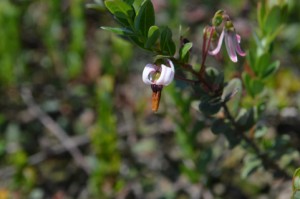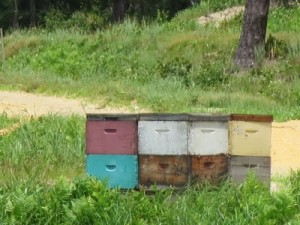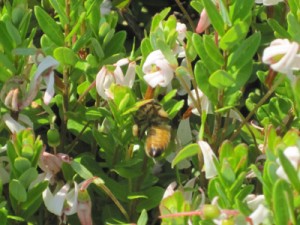A good fall harvest depends on a successful growing and pollination season, and cranberry growers, like many fruit growers, rely on honeybees and bumble bees to cross pollinate blossoms. Production and yield is directly tied to good pollination and subsequent fruit set. In addition, pollinators are important to native plants, which provide food and cover for numerous wildlife species, as well as helping stabilize the soil and improve water quality. One of the more important elements in the Pine Island Integrated Crop Management (PIICM) program is ensuring adequate pollination; flowers that are not visited by bees rarely produce fruit. To this end, we work with several New Jersey beekeepers to temporarily install hives during the bloom period, usually at the end of May/beginning of June depending on the weather.
“We start planning for this in the winter,” says manager Mike Haines. “I started calling beekeepers in February and March and telling them we’ll need X number of hives. We usually place two per acre. Some experts think we could get away with one per acre, Dad knows a Wisconsin grower who will do six or seven . . . but we’re sticking with two. We calculated that meant about 2500 colonies, give or take, which is a lot of bees! So we have to ask a few beekeepers; some are comfortable bringing as many as they can, others are more comfortable with a lower number. This way, everyone’s happy.” He also thinks the cooler spring has had some effects. “This is my first year working with this, but it feels a bit later,” he says. “We tend to start right after fairy ring applications are done while the plants are still in the hook stage switching over to bloom.” He tries to give the beekeepers as much lead time as he can, and calls about once or twice a week to let them know when the next hives need to be placed. “They have a lot to coordinate on their end, so I try to make it easier. On our end, we make a map with places to drop hives; we need places to put them that are out of the way of people and trucks. People get annoyed at me when they have to walk down a ramp directly next to a lot of bees!” Placement order is also based on factors such as variety, when the water came off, and location. “Crimson Queen is our earliest variety and we had bees two weeks ago in there. Early Blacks and Stevens are farthest behind, but most of those will begin by the end of next week. Jeremy [Fenstermaker] and I are combing through the whole farm to make sure we know; we’re a week from needing them here, three days from there . . that helps with the planning.”
The work isn’t done after the bees are in place, either. Team member Tim Bourgeois took a beginner beekeeping class in order to learn more about this fascinating aspect of cranberry production. “It was a really interesting class,” Tim says. “I’d been hearing a lot about the colony collapse disorder, and I really wanted to know more. And since I’m the person who works on treatments and applications, I thought it’d be good to have at least one person on the farm familiar with bees in general; bee care, health, maintenance, things like that. The class focused on beginning beekeeper information: anatomy, food source requirements, hive care and maintenance, bee colony care and maintenance, how to establish a colony, and items related to that. It didn’t cover renting hives, since it’s a beginning course, but it was a lot of really good information.” The plan is for Tim to accompany the state apiary inspector the next time he comes by to check the hives: “I’ll ride along with him and he’ll give me some pointers of thing to look for, make sure hives are healthy and the bees are doing what they’re supposed to.”



